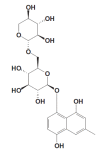Persimmon (Diospyros kaki) fruit: hidden phytochemicals and health claims
- PMID: 27047315
- PMCID: PMC4817420
- DOI: 10.17179/excli2015-159
Persimmon (Diospyros kaki) fruit: hidden phytochemicals and health claims
Abstract
Currently, nutrition and health linkages focused on emerging strategy of diet based regimen to combat various physiological threats including cardiovascular disorders, oxidative stress, diabetes mellitus, etc. In this context, consumption of fruits and vegetables is gaining considerable importance as safeguard to maintain human health. Likewise, their phytochemicals and bioactive molecules are also becoming popular as promising demulcent against various ailments. The current review is an effort to sum up information regarding persimmon fruit with special reference to its phytochemistry and associated health claims. Accordingly, the role of its certain bioactive molecules like proanthocyanidin, carotenoids, tannins, flavonoids, anthocyanidin, catechin, etc. is highlighted. Owing to rich phytochemistry, persimmon and its products are considered effective in mitigating oxidative damage induced by reactive oxygen species (ROS). The antioxidant potential is too responsible for anti-malignant and anti-melanogenic perspectives of persimmon functional ingredients. Additionally, they are effectual in soothing lifestyle related disparities e.g. cardiovascular disorders and diabetes mellitus. There are proven facts that pharmacological application of persimmon or its functional ingredients like proanthocyanidin may helps against hyperlipidemia and hyperglycemia. Nevertheless, astringent taste and diospyrobezoars formation are creating lacuna to prop up its vitality. In toto, persimmon and its components hold potential as one of effective modules in diet based therapy; however, integrated research and meta-analysis are still required to enhance meticulousness.
Keywords: astringency; cardiovascular disorders; diabetes mellitus; oxidative stress; persimmon; phytochemicals; tannins.
Figures









Similar articles
-
In Vitro and In Vivo Digestion of Persimmon and Derived Products: A Review.Foods. 2021 Dec 11;10(12):3083. doi: 10.3390/foods10123083. Foods. 2021. PMID: 34945634 Free PMC article. Review.
-
Persimmon (Diospyros kaki L.) leaves: a review on traditional uses, phytochemistry and pharmacological properties.J Ethnopharmacol. 2015 Apr 2;163:229-40. doi: 10.1016/j.jep.2015.01.007. Epub 2015 Jan 28. J Ethnopharmacol. 2015. PMID: 25637828 Review.
-
Influence of ripening stage and de-astringency treatment on the production of dehydrated persimmon snacks.J Sci Food Agric. 2021 Jan 30;101(2):603-612. doi: 10.1002/jsfa.10672. Epub 2020 Aug 12. J Sci Food Agric. 2021. PMID: 32683710
-
From Diospyros kaki L. (Persimmon) Phytochemical Profile and Health Impact to New Product Perspectives and Waste Valorization.Nutrients. 2021 Sep 20;13(9):3283. doi: 10.3390/nu13093283. Nutrients. 2021. PMID: 34579162 Free PMC article. Review.
-
The persimmon (Diospyros oleifera Cheng) genome provides new insights into the inheritance of astringency and ancestral evolution.Hortic Res. 2019 Dec 18;6:138. doi: 10.1038/s41438-019-0227-2. eCollection 2019. Hortic Res. 2019. PMID: 31871686 Free PMC article.
Cited by
-
In Vitro and In Vivo Digestion of Persimmon and Derived Products: A Review.Foods. 2021 Dec 11;10(12):3083. doi: 10.3390/foods10123083. Foods. 2021. PMID: 34945634 Free PMC article. Review.
-
Stress and Cardiometabolic Disease Risk for Indigenous Populations throughout the Lifespan.Int J Environ Res Public Health. 2021 Feb 13;18(4):1821. doi: 10.3390/ijerph18041821. Int J Environ Res Public Health. 2021. PMID: 33668461 Free PMC article.
-
Effects of Persimmon (Diospyros kaki L. cv. Mopan) Polysaccharide and Their Carboxymethylated Derivatives on Lactobacillus Strains Proliferation and Gut Microbiota: A Comparative Study.Int J Mol Sci. 2023 Oct 29;24(21):15730. doi: 10.3390/ijms242115730. Int J Mol Sci. 2023. PMID: 37958715 Free PMC article.
-
Investigation into Polyphenol Profile and Biological Activities of Enriched Persimmon/Apple Smoothies during Storage.Foods. 2023 Aug 29;12(17):3248. doi: 10.3390/foods12173248. Foods. 2023. PMID: 37685183 Free PMC article.
-
The leaves of Diospyros kaki exert beneficial effects on a benzalkonium chloride-induced murine dry eye model.Mol Vis. 2016 Apr 2;22:284-93. eCollection 2016. Mol Vis. 2016. PMID: 27110091 Free PMC article.
References
-
- Achiwa Y, Hibasami H, Katsuzaki H, Imai K, Komiya T. Inhibitory effects of persimmon (Diospyros kaki) extract and related polyphenol compounds on growth of human lymphoid leukemia cells. Biosci Biotechnol Biochem. 1997;61:1099–1101. - PubMed
-
- Ahn HS, Jeon TI, Lee JY, Hwang SG, Lim Y, Park DK. Antioxidative activity of persimmon and grape seed extract: in vitro and in vivo. Nutr Res. 2002;22:1265–1273.
-
- Akagi T, Ikegami A, Yonemori K. DkMyb2 wound-induced transcription factor of persimmon (Diospyros kaki Thunb.), contributes to proanthocyanidin regulation. Planta. 2010;232:1045–1059. - PubMed
-
- Akter MS, Ahmed M, Eun JB. Effect of blanching and drying temperatures on the physicochemical characteristics, dietary fiber composition and antioxidant-related parameters of dried persimmons peel powder. Int J Food Sci Nutr. 2010;61:702–712. - PubMed
-
- Akyıldız A, Aksay S, Benli H, Kıroğlu F, Fenercioğlu H. Determination of changes in some characteristics of persimmon during dehydration at different temperatures. J Food Eng. 2004;65:95–99.
Publication types
LinkOut - more resources
Full Text Sources
